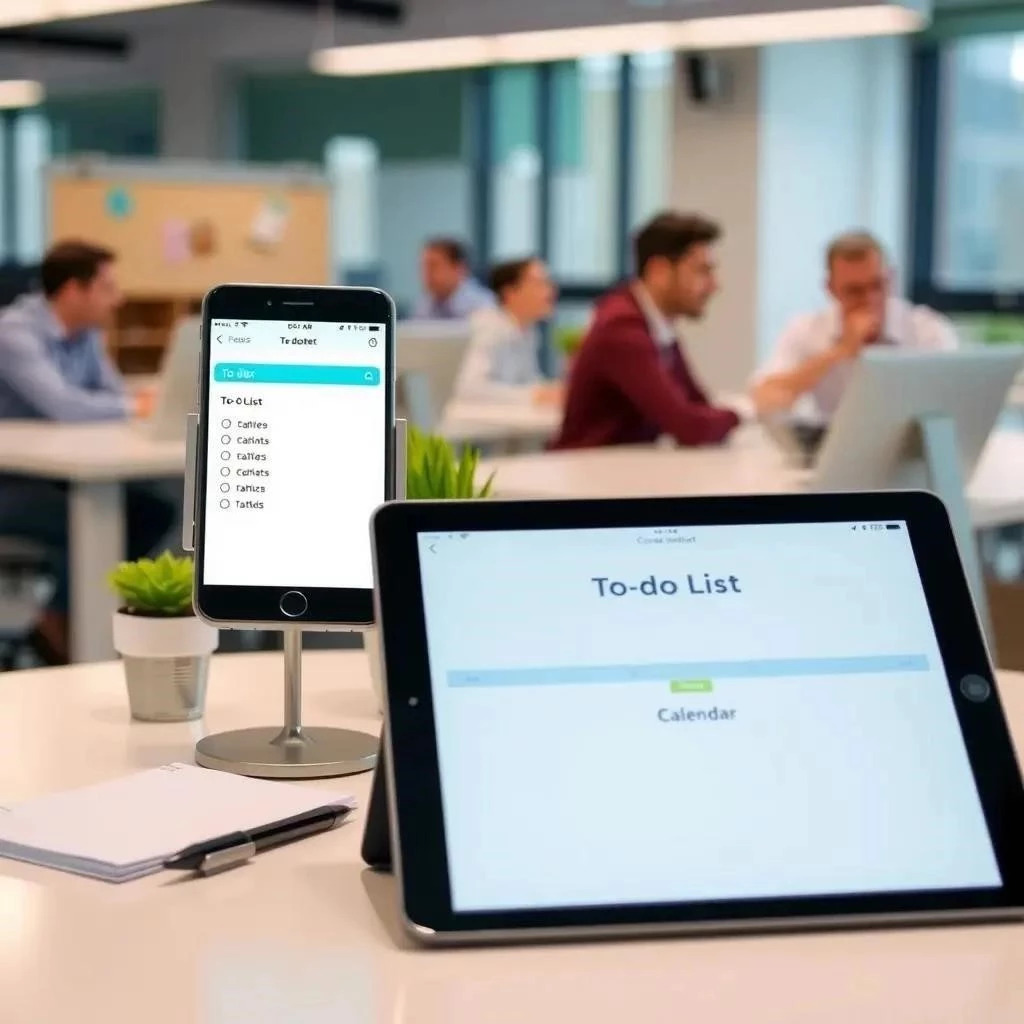In today’s fast-paced world‚ maintaining optimal work organization can feel like an insurmountable challenge․ We’re constantly bombarded with tasks‚ deadlines‚ and distractions‚ making it difficult to stay on top of everything․ Luckily‚ technology offers a lifeline in the form of mobile applications specifically designed to boost productivity and streamline workflow․ These powerful tools‚ when used strategically‚ can transform chaos into calm‚ empowering you to manage your time‚ tasks‚ and communication effectively․ Learning how to organize your work perfectly with a help of mobile apps is no longer a dream‚ but a tangible reality within reach for anyone willing to embrace the digital age․
Choosing the Right Mobile Apps for Work Organization
The sheer number of mobile apps available can be overwhelming․ It’s crucial to identify your specific needs and choose apps that align with your workflow․ Consider these factors:
- Task Management: Do you need a simple to-do list or a more complex project management tool?
- Time Tracking: Are you looking to monitor how you spend your time on different tasks?
- Note-Taking: Do you need a place to jot down ideas‚ meeting notes‚ or research findings?
- Communication: Do you require a secure and efficient way to communicate with colleagues and clients?
Once you’ve identified your needs‚ research and compare different apps․ Read reviews‚ watch tutorials‚ and try out free trials before committing to a specific platform․ Remember that the “best” app is subjective and depends on your individual preferences and work style․
Essential Mobile Apps for Enhanced Productivity
Here are a few examples of popular and highly-rated mobile apps that can significantly improve your work organization:
- Todoist: A versatile task management app with features like recurring tasks‚ due dates‚ and collaboration․
- Trello: A visual project management tool that uses boards‚ lists‚ and cards to organize tasks․
- Evernote: A comprehensive note-taking app that allows you to create notes‚ clip web articles‚ and scan documents․
- Slack: A powerful communication platform for teams‚ with channels‚ direct messaging‚ and file sharing․
Leveraging App Features for Optimal Organization
Simply downloading apps is not enough․ You need to learn how to use them effectively to maximize their benefits․ Here are some tips:
- Set clear goals and priorities: Define what you want to achieve with each app and focus on the most important tasks․
- Use tags and categories: Organize your tasks‚ notes‚ and files using tags and categories to make them easily searchable;
- Automate repetitive tasks: Utilize app features like recurring tasks and reminders to automate routine activities․
- Integrate with other apps: Connect your apps to create a seamless workflow and avoid switching between platforms․
Integrating your mobile apps is key to a streamlined workflow․ For instance‚ connect your task management app with your calendar to schedule tasks and set reminders․ Link your note-taking app with your research tools to easily access and organize information․ By creating a cohesive ecosystem of apps‚ you can significantly reduce distractions and boost productivity․
FAQ: Mobile Apps for Work Organization
- Q: Are mobile apps really effective for work organization?
- A: Yes‚ when used strategically‚ mobile apps can significantly improve productivity‚ time management‚ and communication․
- Q: Which mobile app is the best for work organization?
- A: The “best” app depends on your individual needs and preferences․ Experiment with different apps to find the ones that work best for you․
- Q: How can I avoid getting distracted by mobile apps?
- A: Turn off notifications‚ set time limits for app usage‚ and create a dedicated workspace to minimize distractions․
Mastering how to organize your work perfectly with a help of mobile apps requires experimentation and a commitment to developing new habits․ Embrace the power of technology‚ and you’ll be well on your way to achieving peak productivity and a more organized work life․
Overcoming Challenges and Maintaining Consistency
While the potential benefits of mobile apps for work organization are undeniable‚ it’s important to acknowledge the potential challenges․ One common pitfall is “app fatigue‚” where users become overwhelmed by the sheer number of apps they’re using and eventually abandon them altogether․ To avoid this‚ be selective in your app choices and focus on mastering a few core tools rather than trying to use everything․ Another challenge is maintaining consistency․ It’s easy to start strong with a new app‚ but it takes discipline to continue using it consistently over time․ Set realistic goals‚ establish routines‚ and track your progress to stay motivated and on track․
The Role of Mindfulness and Digital Wellbeing
Beyond simply using apps‚ cultivating mindfulness and practicing good digital wellbeing habits are crucial for effective work organization․ This involves being aware of your technology usage‚ setting boundaries‚ and prioritizing your mental and physical health․ Consider implementing these strategies:
- Schedule breaks: Regularly step away from your devices to rest your eyes‚ stretch your body‚ and clear your mind․
- Limit notifications: Turn off non-essential notifications to reduce distractions and maintain focus․
- Create a digital detox routine: Dedicate specific times each day or week to disconnect from technology and engage in other activities․
- Practice mindful app usage: Be intentional about how you use your apps and avoid mindless scrolling or multitasking․
The Future of Mobile Work Organization
The landscape of mobile work organization is constantly evolving‚ with new apps and technologies emerging all the time․ Artificial intelligence (AI) and machine learning are playing an increasingly important role‚ automating tasks‚ providing personalized recommendations‚ and optimizing workflows․ We can expect to see even more sophisticated and intuitive apps in the future‚ making it easier than ever to manage our work and achieve our goals․ The key will be to stay informed about these advancements and adapt our strategies accordingly․
Embracing a Holistic Approach
Ultimately‚ achieving perfect work organization requires a holistic approach that encompasses not only mobile apps but also mindful habits‚ effective communication‚ and a clear understanding of your goals and priorities․ By combining the power of technology with a commitment to personal wellbeing‚ you can create a sustainable and fulfilling work life․
Comparative Table: Mobile Apps for Work Organization
| App Name | Primary Function | Key Features | Pros | Cons |
|---|---|---|---|---|
| Todoist | Task Management | Recurring tasks‚ collaboration‚ due dates | User-friendly‚ versatile‚ cross-platform | Can be expensive for advanced features |
| Trello | Project Management | Visual boards‚ lists‚ cards‚ collaboration | Highly visual‚ flexible‚ easy to use for team projects | Can be overwhelming for complex projects |
| Evernote | Note-Taking | Web clipping‚ document scanning‚ organization tools | Comprehensive‚ versatile‚ good for research | Can be cluttered‚ subscription required for full functionality |
| Slack | Communication | Channels‚ direct messaging‚ file sharing | Real-time communication‚ team collaboration‚ integrations | Can be distracting‚ prone to information overload |
As you continue to explore different tools and techniques‚ remember that the journey to perfect work organization is an ongoing process․ Be patient with yourself‚ experiment with different approaches‚ and continuously adapt your strategies to meet your evolving needs․ And remember‚ the ability to perfectly organize your work with a help of mobile apps and other tools is a skill that improves with consistent practice and a willingness to learn․
Staying Ahead of the Curve: Continuous Learning and Adaptation
The digital landscape‚ and with it‚ the realm of mobile applications‚ is in a perpetual state of flux․ New apps emerge‚ existing ones evolve‚ and best practices shift․ To truly master the art of mobile work organization‚ a commitment to continuous learning is paramount․ This doesn’t necessarily mean becoming an expert in every new app that hits the market‚ but rather cultivating an awareness of emerging trends and a willingness to experiment with new tools and techniques․ Consider subscribing to productivity blogs‚ attending webinars on time management‚ and actively seeking feedback from colleagues and peers․ Furthermore‚ regularly review your current app setup and identify areas for improvement․ Are there outdated apps that can be replaced? Are there new features in your existing apps that you’re not utilizing? By embracing a mindset of continuous improvement‚ you can ensure that your mobile work organization strategy remains effective and relevant over time․
The Importance of Customization and Personalization
While there are countless articles and tutorials offering advice on the “best” mobile apps for work organization‚ it’s crucial to remember that there is no one-size-fits-all solution․ What works perfectly for one individual may be completely ineffective for another․ This is because individual work styles‚ preferences‚ and needs vary significantly․ Some people thrive in highly structured environments with detailed task lists and strict deadlines‚ while others prefer a more flexible and adaptable approach․ Therefore‚ it’s essential to customize and personalize your app setup to align with your unique workflow․ Experiment with different apps‚ settings‚ and features to find what resonates with you․ Don’t be afraid to deviate from established best practices if it means creating a more productive and enjoyable work experience․ The key is to find a system that complements your natural tendencies and empowers you to work at your best;
Beyond Apps: The Role of Mindset and Discipline
While mobile apps can undoubtedly be powerful tools for work organization‚ they are ultimately just that – tools․ They are only as effective as the user who wields them․ No matter how sophisticated or feature-rich an app may be‚ it cannot compensate for a lack of discipline‚ focus‚ or a clear understanding of one’s goals․ Therefore‚ it’s essential to cultivate the right mindset and habits to complement your app usage․ This includes setting realistic goals‚ prioritizing tasks effectively‚ minimizing distractions‚ and practicing self-discipline․ Consider incorporating mindfulness techniques into your daily routine to improve focus and concentration․ Establish clear boundaries between work and personal life to prevent burnout․ And remember to celebrate your successes along the way to stay motivated and engaged․ By combining the power of technology with a strong work ethic and a positive mindset‚ you can unlock your full potential and achieve remarkable results․
Addressing Potential Drawbacks: Security and Privacy
In the age of interconnected devices and cloud-based services‚ security and privacy are paramount concerns․ When relying on mobile apps for work organization‚ it’s crucial to be mindful of the potential risks and take steps to mitigate them․ Choose apps from reputable developers with a proven track record of security․ Read the privacy policies carefully to understand how your data is being collected and used․ Enable two-factor authentication whenever possible to protect your accounts from unauthorized access․ Be cautious about sharing sensitive information through mobile apps‚ especially on public Wi-Fi networks․ Regularly update your apps to ensure that you have the latest security patches․ And consider using a password manager to generate and store strong‚ unique passwords for all of your accounts․ By taking these precautions‚ you can minimize the risk of data breaches and protect your sensitive information․

